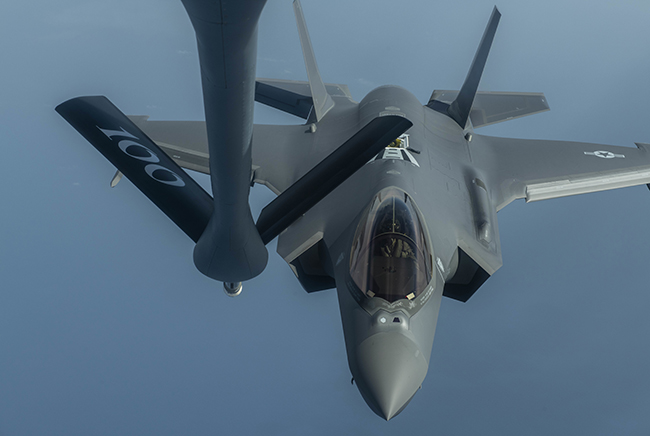
A USAF F-35 Lightning II flies behind a USAF KC-135 Stratotanker before conducting air refueling training for a Theater Security Package over the Mediterranean Sea, on June 11, 2019. Air Force by SrA. Luke Milano.
Lockheed Martin is continuously assessing its F-35 supply chain and eyeing potential alternate vendors, for just such a case as Turkey’s expulsion from the multinational program, company executive vice president for aeronautics Michele Evans said on June 13. It’s likely the Turkish eviction won’t have much effect on cost or schedule of the program writ large, she said.
Evans, after a pre-Paris Air Show briefing for defense journalists, told Air Force Magazine, “with time, we can adjust” the F-35 supply chain to account for disruptions such as Turkey’s ouster. “We are always working with our vendors and suppliers, … and looking for the lowest-cost” approach to building the F-35, she said, noting there is a shop at Lockheed whose sole function is to develop production work-arounds in case of an interruption of supply.
“We can’t afford to wait for things like this to happen,” she said. “We have to be ready with something else” to replace lost vendors. The Pentagon plans to “unwind” Turkey from the F-35 program by early 2020, a date set by defense acquisition and sustainment chief Ellen Lord last week, although immediate steps have been taken to lock Turkey out of this week’s F-35 CEO meeting. Turkish pilots and attaché??s also must disengage from F-35 training and program work by July 31. Lord said she expects the industrial severance to be complete by the first quarter of 2020, barring a reversal of Turkey’s decision to buy Russia’s S-400 air defense system. The S-400 is “incompatible” with the F-35, Lord said.
Evans insisted the issues regarding Turkey’s exit from the program are “government-to-government” and the company will do as it’s directed. She could not offer any information on what might become of tooling and other F-35 industrial equipment now in Turkey.
In other F-35 news, Evans said Lockheed’s ability to deliver the $80 million unit cost on the strike fighter a year ahead of schedule—based on the recent multi-year contract—is proof the company is investing in production technologies and squeezing vendors to extract all possible savings from the project. “We will not take our foot off the gas,” she said, noting Lockheed hopes to reduce the unit cost even further. The burden of cost reductions isn’t falling only on vendors; Lockheed is working hard to trim its own costs so vendors and subcontractors know the cost reductions are an enterprise-wide demand.
As for sustainment costs, which the military services have identified as their biggest heartache with the F-35, Evans said Lockheed stands behind its goal to get costs per flying hour below $25,000 by 2025, and will meet the Air Force’s goal of spending $4.1 million per tail, per year. She also said that Air Force F-35As at Red Flag exercises recently turned in a 90 percent mission capable rate, while Marine Corps F-35Bs chalked up a 75 percent MC rate on the USS Essex.
Intellectual property rights, often a hangup in previous F-35 negotiations, will be less so in the future, Evans said. While return of value to Lockheed shareholders is important, “IP is not going to be as valuable as it was” in even the recent past, due to the accelerating rate at which software will be revamped and overtaken by events.
Evans said the F-35 was demonstrated in Switzerland on June 12 and Finland on June 13, and a Marine Corps F-35B flew over the White House on June 12 in honor of the Polish president’s visit. Besides those countries, sales prospects again include Canada, and Evans said she hopes Germany will reconsider the F-35. Belgium recently ordered the jet, Japan significantly increased its order, and Singapore will buy a quartet of Lightnings with options for eight more.